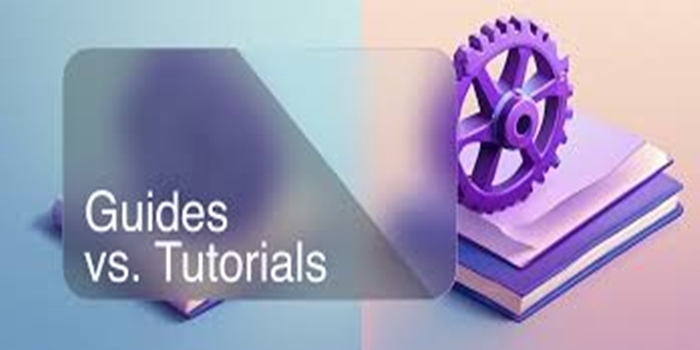In this article, we talked about the meaning of guides and tutorials, the benefits, the types, we also discussed about the different between them.
Definition
Guide is an act to direct in a way or course. He guided us around the city. to direct, supervise, or influence usually to a particular end. Guide is a person who shows the way to others, especially one employed to show tourists around places of interest.
Tutorials: Designed to help people learn and have a successful learning experience. Tutorials are often more interactive and specific than lectures or books, and they teach by example. Tutorials can be in-person or online, and they can include step-by-step instructions and support.
Here are some tips for learning from tutorials:
Think about what you’re going to build
Try building some of it on your own first
Pause the video to process information and ask questions
Break down the finished project and rebuild it in your own way
Guides and tutorials can have many benefits, including:
Improved learning
Tutorials can help people learn more quickly and retain information longer. They can also help people with learning disabilities or those studying in a foreign language.
Increased engagement
Video tutorials can be more effective than text-based content at capturing attention and helping people retain information.
Reduced support costs
User guides can reduce the need for customer support by providing self-help resources.
Efficient training
Tutorials can help employees save time and increase productivity by providing clear instructions on how to complete tasks or use software.
Boosted confidence
Tutorials can help boost confidence by providing people with the tools and knowledge they need to succeed.
Greater self-discipline
Tutorials can allow people to practice self-discipline.
On-demand learning
Tutorials can be done independent of time and geography.
Easier to review
Tutorials can be easier to briefly review or skip sessions if not a beginner.
Here are some types of guides and tutorials:
Video tutorials
Can be used to introduce new concepts, explain complex processes, or provide overviews of a product’s features.
Onboarding checklists
Can be used to guide new users through a product by leading them to complete a set of actions in a specific order.
Instructional videos
Can be used for education and L&D purposes, such as onboarding new employees about a company.
Interactive walkthroughs
Can help users navigate a product’s learning curve and make it easier to use.
Screencasts
Teach something that happens on a computer screen while the user performs the task and narrates it.
Tooltips
Targeted pop-ups that explain how a new feature works and its best use cases.
Explanation guides
Clarify a single topic in an app, and link to how-tos, tutorials, or a getting started guide.
Micro videos
Brief instructional videos that focus on teaching a specific topic without going into too much depth.
The Different Between Guide and Tutorials
A “guide” generally provides broader information and may offer multiple approaches to achieve a task, assuming some prior knowledge, while a “tutorial” focuses on teaching a specific skill or concept through detailed, step-by-step instructions, often aimed at beginners with little prior knowledge.
Key differences:
Level of detail:
Guides tend to be more concise, offering an overview and potential pathways, while tutorials provide in-depth explanations with clear steps to follow.
Target audience:
Guides are usually for users who already have a basic understanding and need to accomplish a specific task, whereas tutorials are designed for learners who are new to a topic and need to acquire foundational knowledge.
Flexibility:
Guides might present different options or approaches to a task, while tutorials typically follow a single, structured path to achieve a specific goal.
Example scenarios:
Guide:
A “troubleshooting guide” for a software issue, outlining potential causes and solutions, allowing users to diagnose the problem based on their situation.
Tutorial:
A “how-to create a basic graphic design” tutorial, walking users through the steps of opening a design program, selecting tools, and applying basic design elements.
Conclusion
A tutorial serves the needs of the user who is at study. Its obligation is to provide a successful learning experience. A how-to guide serves the needs of the user who is at work. Its obligation is to help the user accomplish a task.


